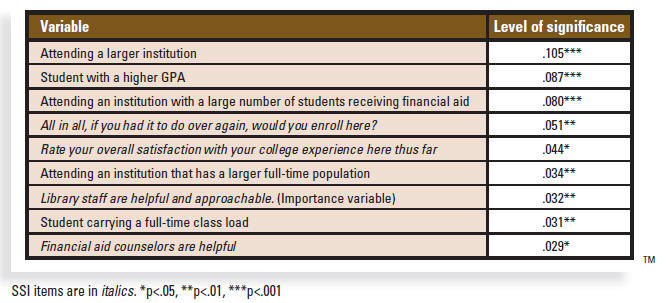student success
Predicting student retention at community colleges
Enrollment at community colleges has been a hot topic lately, especially following President Obama’s announced plan to provide tuition-free classes for students at two-year institutions. In a recent blog, my colleague Mari Normyle shared some reactions based on assumptions about community college students and the quality of their educational experience. The data she shared may counteract some common assumptions people have about community college students (especially their commitment to academics), which illustrates why it is important to study and analyze the data about college student attitudes and behaviors.
One assumption many have is that when college students are satisfied, they are more likely to persist and complete their educations. Noel-Levitz has investigated this topic in recent years. We published a study by Dr. Laurie Schreiner called Linking Student Satisfaction and Retention, which found a significant link between satisfaction and persistence at four-year institutions. In another study last year, The Relationship of Student Satisfaction to Key Indicators for Colleges and Universities, my colleague Scott Bodfish and I reviewed institutional graduation rates, including those at community colleges, and found that colleges with higher graduation rates were also more likely to have higher student satisfaction scores.
However, while many community colleges have long had a commitment to assessing student satisfaction, there has been little definitive evidence that satisfaction with the experience was linked to individual student persistence at two-year institutions, until now.
Dr. Karen Miller, vice president for access and completion at Cuyahoga Community College (OH), in cooperation with Noel-Levitz, recently completed a national study of 22 institutions and more than 22,000 student records to examine student satisfaction and spring-to-spring persistence. The study, Predicting Student Retention at Community Colleges, is the first study of its kind with a national scope. Dr. Miller looked at student satisfaction and importance data from the Student Satisfaction Inventory (SSI) as well as additional institutional and student demographic variables to see how they predict student retention at community colleges.
In one finding, Dr. Miller concludes that there is a significant connection between a student’s positive responses to the SSI item, “Rate your overall satisfaction with your experience here thus far,” and a community college student’s continued enrollment one year later. Similarly, students with positive responses to the question, “If you had it to over again, would you enroll here?” were also more likely to persist at significant levels.
Nine total variables, including the two highlighted above, were found to have a positive impact on spring-to-spring retention:

Predicting Student Retention at Community Colleges discusses these variables and the ways that community colleges may be able to further improve the student experience in order to impact student retention. Dr. Miller also identifies an additional nine variables that had a negative impact on student persistence.
Further proof that assessing student satisfaction can play a significant role in student retention
Dr. Miller’s findings are just the latest in many years of studies that have looked at the relationship between college student satisfaction and retention. She actually discusses a history of this research in the report. Her findings and other studies show that campuses can use satisfaction assessment to make a positive impact on student persistence.
With that in mind, are you gathering student satisfaction data regularly from your student population? And more importantly, are you using that data to guide institutional decision making, to affect the student experiences in positive ways? I encourage you to download this study to learn more about what you can do on your campus.
I also want to invite you to join us for a free webinar on student satisfaction assessment to hear directly from two college campuses (Metropolitan Community College in Missouri and Anderson University in Indiana) about how they actively use their satisfaction data for improvement activities. And I invite you to connect with Dr. Miller and I during our session at the American Association of Community Colleges Annual Convention in San Antonio on April 19.
We welcome your comments and discussion on these results as well. Please leave a comment or drop me an email.
